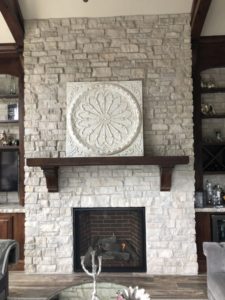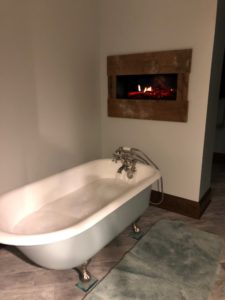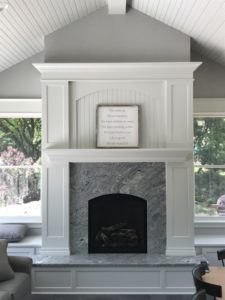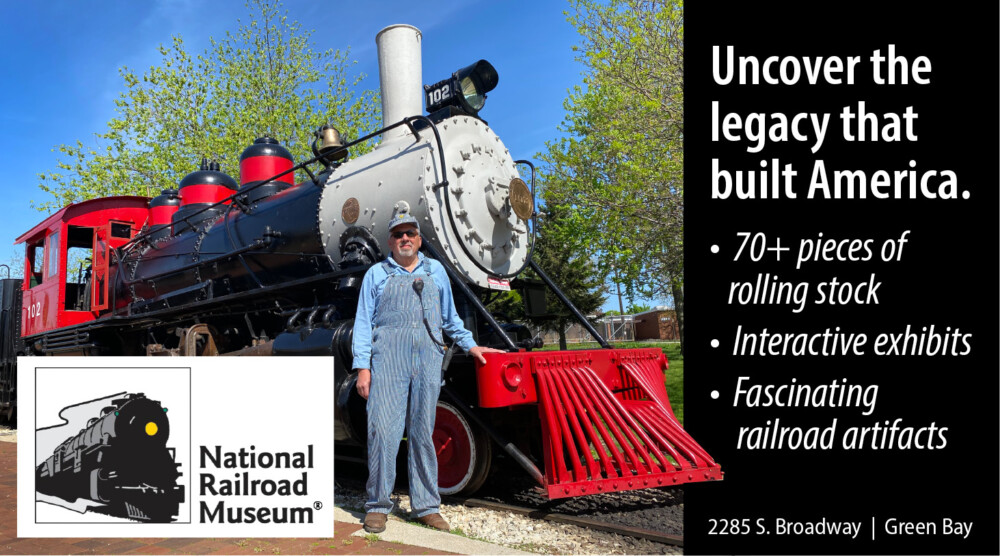What you should know about safety, efficiency and heat
Hello, winter. The season has officially turned and we’re in for the long haul in the Fox Cities. Undoubtedly, when it’s cold outdoors, we crave warmth and coziness inside. Perhaps the most iconic combatant to the frigid temperatures and mental fatigue is the fireplace.
They add literal heat, but it’s about more than that.
“Fireplaces offer a great feel for company, holidays, and can set the mood in any room,” Jake Le Noble, co-owner of Tundra Stone Products & Fireplace LLC, in Freedom, says. “Some fireplaces add value to homes, businesses and just give the perfect look to the place you love.”
“A fire is an experience for all your senses, not just sight or heat,” Alison Van Lanen, owner of Truttmann Hearth Ware, LLC in De Pere, says.
Choosing a fireplace is anything but a one-size-fits-all process. Specifications to consider range from primary purpose, style, home capability, level of maintenance and more. Today’s fireplaces can be customized to exact specifications from aesthetic appeal, heat and even flame height and pattern.
 “One of the first things I ask people is, ‘What do you want out of your fireplace?’ Van Lanen says. “It’s a process and we have to start somewhere!”
“One of the first things I ask people is, ‘What do you want out of your fireplace?’ Van Lanen says. “It’s a process and we have to start somewhere!”
Eric Romenesko, owner of Elite Fireplace LLC in Appleton, agrees.
“We need to gather information to help steer them in the right direction. Show them what’s out there, some of the products that will work for them and help people make educated decisions.”
Wood-burning fireplaces
Wood-burning fireplaces hold a magical charm that’s hard to deny. They conjure iconic images that have history dating back to the 1500s (but became more common in the mid-1700s). They’ve come a long way, and new, high-efficiency versions are a great option if your objective is heating your home.
“The traditional wood-burning fireplace is designed for aesthetics,” Romenesko says. “They’re not airtight… you’re just burning your room air and it’s going up and out. It’s really not providing much heat. In the high-efficiency stuff, all the air used for combustion comes from the outside of the house. It comes in, burns and continually heats the air in your home.”
“Some you can actually pump that heat into your heating system, into your ductwork,” Van Lanen adds.
High-efficiency wood-burning units also allow control over the length of burn time. The maximum amount of air creates approximately 2-3 hours of burn time, but when you slow the air down, it extends it up to about 8-10 hours. Van Lanen says freestanding wood stoves can go up to 30 hours on one load of wood, and can heat up to 2,500 square feet.
“It’s a solid fuel, and with solid fuel burning there’s a little more maintenance,” Van Lanen explains. “You want to make sure your flue is clean and not blocked. If it’s a sealed or high-efficiency word-burning, you want to check the gaskets on your door. If you have a catalytic combustor, make sure that’s clean.”
Gas
Around since the 1850s, gas fireplaces can be hard to spot because they mimic wood-burning units so well. But they allow for even more customization—in general and on a fire by fire basis.
 “You can raise or lower flames with a remote control, you can use a remote control and set a thermostat to a particular temperature,” Van Lanen says. “It’s like a furnace and does not require electricity. You have an alternative heat source.
“You can raise or lower flames with a remote control, you can use a remote control and set a thermostat to a particular temperature,” Van Lanen says. “It’s like a furnace and does not require electricity. You have an alternative heat source.
“Then you have options for the liner inside—you can have it look like stone or like brick, you can have it where it’s mirrored-looking. Do you want logs? Do you want crushed glass, stones, coal? There are all kinds of choices.”
Romenesko adds another benefit to gas fireplaces is location. Installation is easier than wood-burning because they’re able to install the fireplace along an exterior wall. No need for a chimney.
“Gas fireplaces offer an elegant look and feel for any place imaginable–inside or out,” Le Noble says. “They give you the ambiance and warmth with the convenience of a flip of a switch.”
“There’s a lot less maintenance,” Van Lanen agrees. “It’s about checking your venting, making sure no bees or birds have built nests. With a sealed unit, you really just need to clean mineral deposits on the glass. Oh and replacing batteries if you have a remote control!”
Electric
If you’re looking for a beautiful, easy fireplace, electric is the ticket. Most people choose this option for ambiance and ease of use and installation. Electric fireplaces do not require chimneys or venting, and use electricity to ignite the heat and flames. No smoke or fumes are produced.
“Electric is just super easy. I’ve seen a lot of electric traffic lately,” Romenesko says. “Some can get so linear, so trim, the heater is smaller. They do provide a little bit of heat, but primarily they’re more of an aesthetic thing.”
He says installation is also more convenient than with wood-burning or gas options.
“When it comes to electric, for sure ease of installation is a piece of it. Sometimes they’re in bedrooms, two-story homes. You have to run a chimney for wood-burning, there’s no getting around that… a lot of times people don’t have the flexibility to get things vented so they go with electric.”
Energy-efficiency + Aesthetics
“Today, people are all about efficiency and converting (fireplaces) to gas is huge,” Romenesko says. It’s a really big thing for us right now.”
There are two ways to go about the conversion: a simple gas log conversion, running a gas line into your fireplace and using concrete logs or gas inserts. The latter is a more involved process, but imitate a new gas fireplace and produce a lot of heat.
 “High-efficiency fireplaces are going to burn in excess of 75% efficient,” Romenesko says. “They are designed to heat very well. For people who want to heat their homes, that’s the direction they want to go.”
“High-efficiency fireplaces are going to burn in excess of 75% efficient,” Romenesko says. “They are designed to heat very well. For people who want to heat their homes, that’s the direction they want to go.”
“When it comes to style, I think the trends are really clean lines where in years past you used to see a lot of fireplaces with little louvers that go across the top and bottom,” Romenesko says. “Now it’s clean-faced fireplaces. Linear fireplaces, smaller, longer ones. They’re just unique, they’re different. They have lights that shine, crushed glass.”
There are even some aesthetic upgrades that are simple enough for homeowners to make themselves.
“A lot of people want to upgrade their fireplaces, for example, the brass on the front,” Tammy Kasten, Sales and Operations Manager at Elite Fireplace Elite LLC, says. “You can use a simple can of spray paint… it’s called Stove Bright (High Temperature Paint)… in the ‘80s and ‘90s you saw brass faces on all the fireplaces, now people are choosing black. I call it the little black dress of your home.”
Safety
The fireplace industry is a highly regulated one. The U.S. Environmental Protection Agency (EPA) works closely with specialty stores like Elite Fireplace LLC and Truttmann Hearth Ware, LLC to come up with new performance standards and effectively dictates what they can sell, showcase and install. New standards went into effect May 15, 2021.
“We’re bringing fire into the home and we want to make sure we’re doing that as safely as we can,” Van Lanen says. “I would tell somebody to be cautious of the big box stores that sell non-standardized products.”
Required maintenance varies by type of fireplace, with woodburning demanding the most attention; then gas, then electric.
“I would absolutely recommend at minimum looking at your chimney on a yearly basis to see if it needs to be cleaned,” Romenesko says. “We do yearly cleanups for gas, kind of like they do for furnaces. We’ll come over and take the logs off, take the burner out. Clean everything in it and set everything to factory specifications.”
“Have a carbon monoxide detector!” Kasten urgently adds. “You’re burning fuel. When you have that burning in your home, there is that potential for something to go wrong.”
 If you’re considering installing a fireplace or converting a traditional unit to a higher-efficiency, be prepared to wait—but also to start the process sooner rather than later.
If you’re considering installing a fireplace or converting a traditional unit to a higher-efficiency, be prepared to wait—but also to start the process sooner rather than later.
“Industry wide, sourcing products is really difficult right now,” Romenesko says. “People were staying home during the pandemic and investing in their homes. Part of that is fireplaces. Demand has spiked.
“Most customers don’t think about fireplaces until it gets cold, until the first day that it freezes. There’s a long lead time.”


